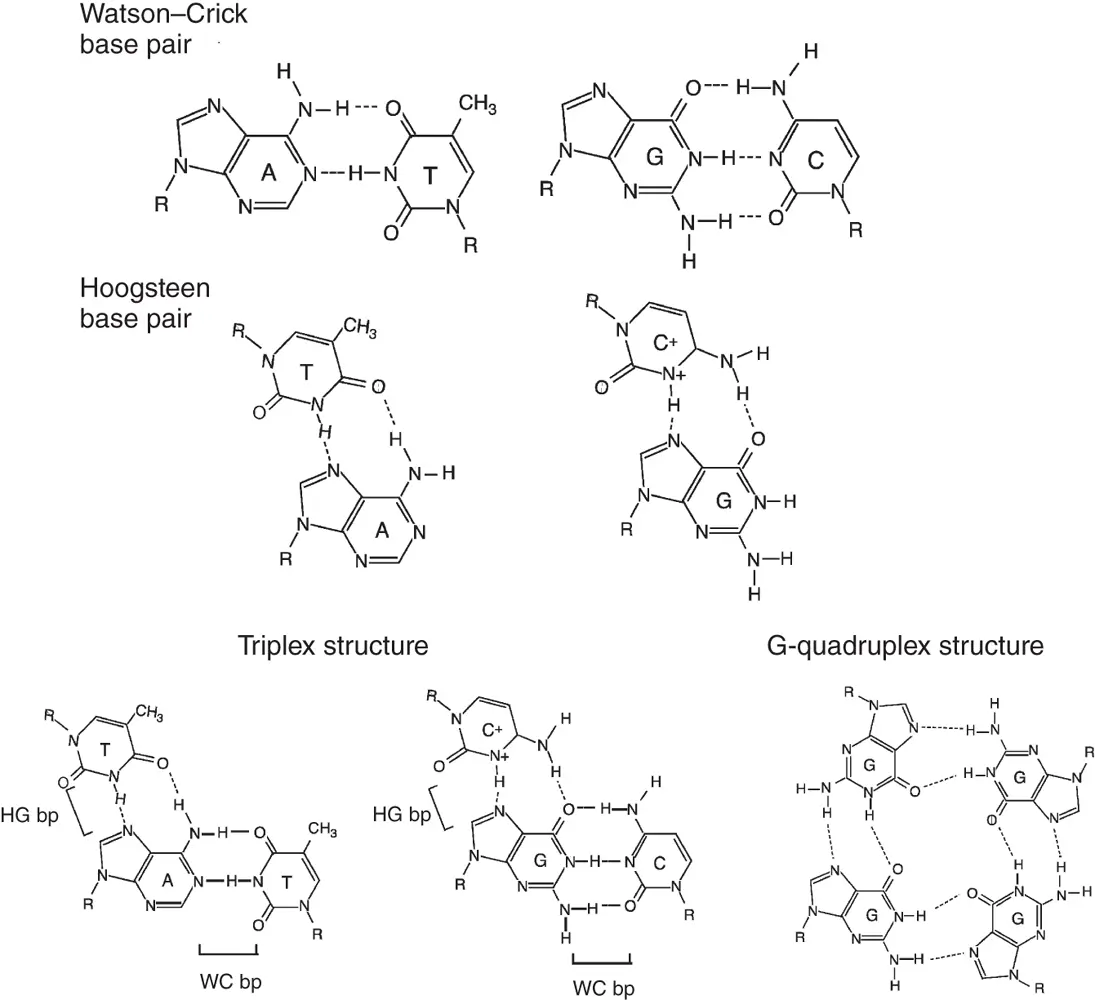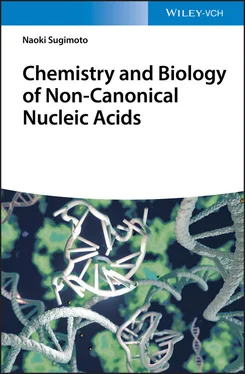Figure 1.1 The diffraction pattern of the canonical DNA duplex and its chemical structure.
Source: Kings College London.
 Erwin Rudolf Josef Alexander Schrödinger (left) and Erwin Chargaff (right)
Erwin Rudolf Josef Alexander Schrödinger (left) and Erwin Chargaff (right)  Maurice Hugh Frederick Wilkins (left) and Rosalind Elsie Franklin (right)
Maurice Hugh Frederick Wilkins (left) and Rosalind Elsie Franklin (right)  James Dewey Watson and Francis Harry Compton Crick
James Dewey Watson and Francis Harry Compton Crick
1.3 Non-Watson–Crick Base Pair
Although the discovery of Watson–Crick base pairs is famous, we need to make sure that Watson and Crick initially “proposed” their model. Moreover, Watson and Crick were not the first researchers who proposed the structure of nucleic acids. The physicist Linus Pauling, who earned the Nobel Prize two times in his career, first proposed the helix model of nucleic acids with his associate Robert Corey [4]. However, the structure was fault: it was a triple helix having negatively charged phosphates located at the core of the helix, which could not exist in nature. After the proposal of Watson–Crick base pairs, the race for determination of the helical structure of DNA had been started using purine and pyrimidine monomers. The first such study was reported in 1959, when Karst Hoogsteen – an associate of Robert Corey at Caltech – used single-crystal X-ray analysis to determine the structures of cocrystals containing 9-methyladenine and 1-methylthymine, where methyl groups were used to block hydrogen bonding to nitrogen atoms otherwise bonded to sugar carbons in DNA [5]. However, the structure was NOT Watson–Crick base pair, in which the adenine base was flipped upside down. The different base pair was later named Hoogsteen base pair ( Figure 1.2and see Chapter 2). After the discovery of Hoogsteen base pairs, many researchers looked for Watson–Crick base pairs. However, only Hoogsteen base pairs were identified. In 1973, Alexander Rich first discovered Watson–Crick base pairs in the cocrystal of the AU and GC dinucleoside phosphate complex [6]. And soon after, Richard E. Dickerson, who took over the Pauling's lab, first solved the single-crystal structure of a DNA dodecamer using heavy atom X-ray crystallography in 1980 [7]. It takes more than 20 years after the discovery of Watson–Crick base pairs. These results suggest that Watson–Crick base pairs tended to stably form under the constraint of the helical structure of nucleic acids, whereas Hoogsteen base pairs form in other structural conditions. Therefore, there are canonical structures composed by Watson–Crick base pairs in the duplex structures. On the other hand, non-canonical structures include non-Watson–Crick base pairs such as Hoogsteen base pairs.

Figure 1.2 Chemical structures of base pairs via Watson–Crick or Hoogsteen types.
 Linus Pauling (left), Robert Corey (middle), and Karst Hoogsteen (right)
Linus Pauling (left), Robert Corey (middle), and Karst Hoogsteen (right)  Alexander Rich (left) and Richard E. Dickerson (right)
Alexander Rich (left) and Richard E. Dickerson (right)
1.4 Nucleic Acid Structures Including Non-Watson–Crick Base Pairs
Behind the extensive efforts to identify the duplex structure of Watson–Crick base pairs, Hoogsteen base pairs were also found in the structure of nucleic acids in the 1960s. Felsenfeld and Rich explained how poly(rU) strands might associate with poly(rA)-poly(rU) duplexes to form triplexes [8]. From the chemical shift of NMR, they identified evidence for triplex formation via protonated G–C +Hoogsteen base pairs at cytosine N3 in a poly(dG)-poly(dC) complex with dGMP at low pH [9]. In 1962, it was found that short guanine-rich stretches of DNA could assume unusual structures [10]. The diffraction studies of poly(guanylic acid) gels suggested that if four guanines were close enough together, they could form planar hydrogen-bonded arrangements now called guanine quartets (G-quartets). With a stack of a few G-quartets, a tetraplex structure is formed called as G-quadruplex (see Chapter 2). In the crystal structure, Hoogsteen base pairs of polynucleic acids were first found in tRNA structure [11]. In the structure Watson–Crick base pairs formed the secondary structure of tRNA, whereas Hoogsteen base pairs supported the tertiary structure. Not only Hoogsteen base pairs but also other types of non-Watson–Crick base pairs were found in tRNA structures. The tertiary structure of nucleic acids is important especially for non-coding RNAs, which do not code genetic information. The landmark of research of non-coding RNA is the discovery of ribozyme (ribonucleic acid enzyme) by Thomas Robert Cech in 1982 [12]. Ribozymes catalyze chemical reactions as well as protein enzymes. Later structural studies revealed that there are a lot of non-Watson–Crick base pairs to produce the active core of enzymatic reaction of ribozymes. Therefore, non-canonical Watson–Crick base pairs including Hoogsteen base pairs have been thought of as a tool for the tertiary structure of nucleic acids except for duplexes.
 Thomas Robert Cech
Thomas Robert Cech
With the progress of structural analysis technology in the 1990s, Hoogsteen base pairs are gradually revealed to exist in DNA complexes with low molecular weight compounds and proteins as well as transiently in Watson–Crick-type double helix. Furthermore, another type of tetraplex structures was identified from DNA sequence enriched in cytosine due to the cross intercalations of hemiprotonated cytosine–cytosine (C–C +) base pairs under acidic conditions [13]. This tetraplex is called as i-motif (see Chapter 2). Soon after, the roles of the non-canonical structures have been gaining attention. Especially since the 2000s, research on the G-quadruplex structure formed from Hoogsteen base pairs has made remarkable progress. When a G-quadruplex is formed on DNA or RNA, the reactivity of the protein involved in gene expression is affected (see Chapters 6– 8). This means that the central dogma proposed by Crick – that genetic information is determined centrally by the flow of replication, transcription, and translation – is highly controlled by the formation of a G-quadruplex structure. In general, it has been thought that the regulation of gene information expression is due to protein functions. However, the specific structure of Hoogsteen base pairs controls gene expression so that the nucleic acid itself can function like a protein. That is, the roles of nucleic acids might be properly used according to base pairs: Watson Crick base pair = information, non-Watson Crick base pair = function. Many sequences that can have a G-quadruplex structure are distributed in the telomere at the end of the chromosome and the promoter region of the oncogene of the gene. Starting with the 2013 report, there have been many reports on the formation of G-quadruplexes and i-motifs in cells. These reports point out that the oncogene may be activated by the formation (or dissociation) of the G-quadruplex to cause cancer (see Chapter 11). Furthermore, it has been suggested that the phase-separated structure formed by the aggregation of RNAs with G-quadruplexes contributes to neurological diseases such as amyotrophic lateral sclerosis (see Chapter 12).
Читать дальше

 Erwin Rudolf Josef Alexander Schrödinger (left) and Erwin Chargaff (right)
Erwin Rudolf Josef Alexander Schrödinger (left) and Erwin Chargaff (right)  Maurice Hugh Frederick Wilkins (left) and Rosalind Elsie Franklin (right)
Maurice Hugh Frederick Wilkins (left) and Rosalind Elsie Franklin (right)  James Dewey Watson and Francis Harry Compton Crick
James Dewey Watson and Francis Harry Compton Crick
 Linus Pauling (left), Robert Corey (middle), and Karst Hoogsteen (right)
Linus Pauling (left), Robert Corey (middle), and Karst Hoogsteen (right)  Alexander Rich (left) and Richard E. Dickerson (right)
Alexander Rich (left) and Richard E. Dickerson (right) Thomas Robert Cech
Thomas Robert Cech










